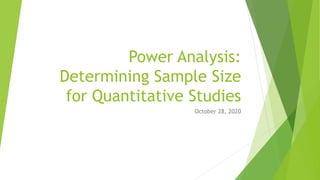Power Analysis: Determining Sample Size for Quantitative Studies
•Télécharger en tant que PPTX, PDF•
0 j'aime•1,175 vues
In this webinar, we go over how to determine the appropriate sample size for a quantitative study by using power analysis. The presentation includes an explanation of what a power analysis is and examples of how to conduct power analyses for common statistical tests. The presentation focuses on power analysis using G*Power and Intellectus Statistics software programs. Sample size calculations for more advanced analyses are briefly discussed.
Signaler
Partager
Signaler
Partager

Recommandé
Contenu connexe
Tendances
Tendances (20)
Observational Studies and their Reporting Guidelines

Observational Studies and their Reporting Guidelines
Parametric and non parametric test in biostatistics 

Parametric and non parametric test in biostatistics
Similaire à Power Analysis: Determining Sample Size for Quantitative Studies
Similaire à Power Analysis: Determining Sample Size for Quantitative Studies (20)
CORE: May the “Power” (Statistical) - Be with You!

CORE: May the “Power” (Statistical) - Be with You!
Sample Size Estimation and Statistical Test Selection

Sample Size Estimation and Statistical Test Selection
5 essential steps for sample size determination in clinical trials slideshare

5 essential steps for sample size determination in clinical trials slideshare
Data Analytics, Machine Learning, and HPC in Today’s Changing Application Env...

Data Analytics, Machine Learning, and HPC in Today’s Changing Application Env...
sience 2.0 : an illustration of good research practices in a real study

sience 2.0 : an illustration of good research practices in a real study
Plus de Statistics Solutions
Plus de Statistics Solutions (20)
Navigating Writing Advice to Get Your Dissertation Moving

Navigating Writing Advice to Get Your Dissertation Moving
Confidently Present Your Quantitative Results Chapter 

Confidently Present Your Quantitative Results Chapter
Attitude, Committee Selection, and Topic Development

Attitude, Committee Selection, and Topic Development
7 Secrets to Completing your Dissertation in One Year

7 Secrets to Completing your Dissertation in One Year
Addressing Feedback- Getting Through Quickly and Efficiently

Addressing Feedback- Getting Through Quickly and Efficiently
Dernier
God is a creative God Gen 1:1. All that He created was “good”, could also be translated “beautiful”. God created man in His own image Gen 1:27. Maths helps us discover the beauty that God has created in His world and, in turn, create beautiful designs to serve and enrich the lives of others.
Explore beautiful and ugly buildings. Mathematics helps us create beautiful d...

Explore beautiful and ugly buildings. Mathematics helps us create beautiful d...christianmathematics
Dernier (20)
On National Teacher Day, meet the 2024-25 Kenan Fellows

On National Teacher Day, meet the 2024-25 Kenan Fellows
Explore beautiful and ugly buildings. Mathematics helps us create beautiful d...

Explore beautiful and ugly buildings. Mathematics helps us create beautiful d...
Role Of Transgenic Animal In Target Validation-1.pptx

Role Of Transgenic Animal In Target Validation-1.pptx
Unit-V; Pricing (Pharma Marketing Management).pptx

Unit-V; Pricing (Pharma Marketing Management).pptx
Beyond the EU: DORA and NIS 2 Directive's Global Impact

Beyond the EU: DORA and NIS 2 Directive's Global Impact
Measures of Central Tendency: Mean, Median and Mode

Measures of Central Tendency: Mean, Median and Mode
Web & Social Media Analytics Previous Year Question Paper.pdf

Web & Social Media Analytics Previous Year Question Paper.pdf
ICT Role in 21st Century Education & its Challenges.pptx

ICT Role in 21st Century Education & its Challenges.pptx
Presentation by Andreas Schleicher Tackling the School Absenteeism Crisis 30 ...

Presentation by Andreas Schleicher Tackling the School Absenteeism Crisis 30 ...
Energy Resources. ( B. Pharmacy, 1st Year, Sem-II) Natural Resources

Energy Resources. ( B. Pharmacy, 1st Year, Sem-II) Natural Resources
Seal of Good Local Governance (SGLG) 2024Final.pptx

Seal of Good Local Governance (SGLG) 2024Final.pptx
Power Analysis: Determining Sample Size for Quantitative Studies
- 1. Power Analysis: Determining Sample Size for Quantitative Studies October 28, 2020
- 2. Presentation Overview Why is sample size important? What is statistical power? What is a power analysis? Basics of G*Power Power analysis examples Sample size calculation for advanced analyses Questions
- 3. Why is sample size important? The ability to find statistically significant results depends on sample size. Higher sample size = greater chance that results will be significant Lower sample size = lower chance that results will be significant Increasing your sample size will increase the “sensitivity” of your statistical test. If you do not have a large enough sample, important effects/differences may go undetected.
- 4. Why is sample size important? Can your sample size be too large?
- 5. Why is sample size important?
- 6. What is statistical power? Statistical power is the probability of finding a statistically significant effect in the sample if the effect actually exists in the population. Power = 1 – Type II error rate Type II error: Failing to detect an effect that actually exists (false negative) Standard for statistical power is .80 We want to have at least an 80% chance of finding statistical significance if the effect/difference does, indeed, exist.
- 7. What is a power analysis? A power analysis is an objective way to determine the appropriate sample size for a statistical analysis. The appropriate sample size is calculated based on: Type of analysis being conducted Expected/hypothesized effect size Significance (alpha) level (e.g., .05) Power level (e.g., .80) A priori vs. post hoc power analysis Software packages are available for conducting power analysis (e.g., G*Power).
- 8. Power Analysis Software: G*Power https://www.psychologie.hhu.de/arbeitsgruppen/allgemeine-psychologie- und-arbeitspsychologie/gpower.html
- 9. Power Analysis Software: Intellectus Statistics https://analyze.intellectusstatistics.com
- 10. Example: t-tests
- 11. Example: Analysis of Variance (ANOVA)
- 13. Advanced Analyses What if the type of analysis I am doing is not in G*Power? Factor analysis Structural equation modeling “Rules of thumb” (participant to variable ratio) Simulation studies (Monte Carlo analysis) Wolf, E. J., Harrington, K. M., Clark, S. L., & Miller, M. W. (2013). Sample size requirements for structural equation models: An evaluation of power, bias, and solution propriety. Educational and psychological measurement, 73(6), 913-934.
- 14. Interested in additional help? Schedule a consultation to learn more about what we offer: https://app.hubspot.com/meetings/jeanine/dissertation-consultation
- 15. Questions?
